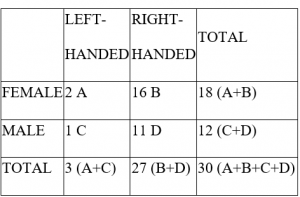Week 4 Discussion: Probability
Required Resources
Read/review the following resources for this activity:
- OpenStax Textbook: Chapter 2, 3
- Lesson
- Minimum of 1 scholarly source
In your reference for this assignment, be sure to include both your text/class materials AND your outside reading(s).
Initial Post Instructions
Probability plays a major role in the medical community. Diagnoses are based on probabilities. They are really questions or “what if’s”, and are answered by the probability that the treatment will be the best for the ailment.
Let’s look at probability in terms of both the real world and the medical community.
- Survey 30 people to find out if they are left-handed or right-handed, and use the following chart to create a contingency table with the information.
Left handed Right handed Total Female Male Total
- Answer the following questions about the information in your contingency table:
- If a person is randomly selected from the survey participants, what is the probability that the person will be left-handed?
- If you randomly choose a female from the people you surveyed, what is the probability that she is left-handed?
- What is the odds ratio of choosing a left-handed female?
- What is the relative risk of choosing a left-handed female?
SOLUTION
Professor and Class,
According to Holmes et al (2018), probability refers to a measure that shows how certain a given outcome is. From my sample of 30 people at the park around my neighborhood is as follows:

- If a person is randomly selected from the survey participants, what is the probability that the person will be left-handed? The probability that the person will be left-handed is 3/30= 0.10
- If you randomly choose a female from the people you surveyed, what is the probability that she is left-handed? The probability that she is left-handed is: 2/18=0.11
- What is the odds ratio of choosing a left-handed female? The odds ratio is calculated as (A/B)/(C/D)=AD/BC 22/16=1.4
- What is the relative risk of choosing a left-handed female? (2/3)/(16/27)= 1.13
According to Orr (2001), more people around the world tend to right-handed, as compared to the left-handed people, as 10-13% of the people are left-handed……..
PLEASE CLICK THE PURCHASE BUTTON TO ACCESS THE ENTIRE COPY AT $5